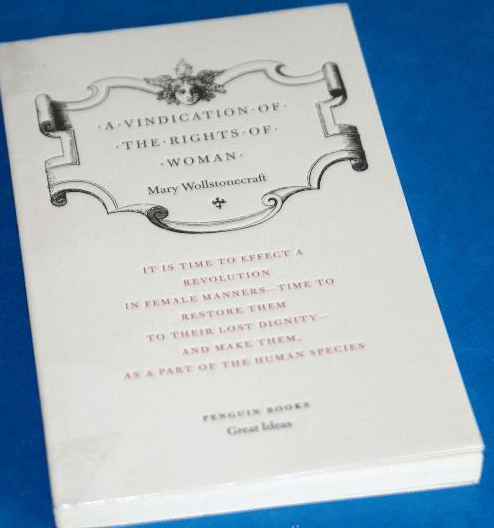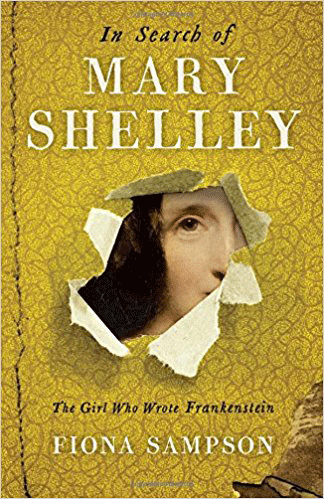The centenary commemoration of Women’s Suffrage has cast a spotlight of the lives of extraordinary women in the last 100 years. However, today I’d like to go a little further back and look at mother and daughter Mary Wollstonecraft and Mary Shelley.

Mary Wollstonecraft was a radical and free thinker. She authored one of the books that form the foundations of the women’s rights movement: A Vindication of the Rights of Woman. Written in 1792 it upholds the importance of education for women and attacks the sexual double standards prevalent at the time, articulating concepts which still resonate over 200 years later. Intellectual society listened – spurred to thoughtfulness by the radical turmoil of the French Revolution – although real social change takes much longer to achieve, as is still all too evident today.
The period at the end of the Enlightenment, the time in which Mary was writing, is explored in A Revolution of Feeling: The Decade That Forged The Modern Mind by Rachel Hewitt. Hewitt’s work is fascinating in that it looks at the emotional impact of social change at the time and the legacy it left behind.
Mary Wollstonecraft’s personal life was unconventional; she travelled widely through revolutionary France and was recognised as a philosopher, writer and intellectual. If you are keen to learn more about her then Claire Tomalin’s biography The Life and Death of Mary Wollstonecraft is a good place to start. Aged 38, she married William Godwin, a man who shared her philosophy, and their partnership looked like it would provide a happy ending to Mary’s hitherto somewhat turbulent life. However, sadly Mary died of puerperal fever following the birth of their daughter, another Mary.
This Mary, born Mary Godwin, who inherited her excellent intellect from both parents and benefited from Godwin’s enlightened views on female education, grew up with a lively and engaging mind. She is better known today under her married name of Mary Shelley, as author of that iconic novel Frankenstein, written 200 hundred years ago this year.
Frankenstein is a surprising book: everyone knows the story – or thinks they do – but they are often relying on hearsay and distorted chimera from screen representations. The first stage versions of this dramatic tale were put on during Mary Shelley’s lifetime; since the advent of cinema it has been filmed numerous times, from early silent movie versions to Hammer Horror adaptations. It has been represented as farce and as horror and, perhaps most famously, in the 1931 film starring Boris Karloff.
However, the familiar bolt-necked monster is a long way from the conflicted creature conceived by Mary Shelley. Subtitled ‘The Modern Prometheus’, her book was about consciousness and responsibility, using the frame of a gothic horror novel for a discussion of philosophical ideas. The original is still available and is well worth a read or re-read.
Monsters, ghosts and horror stories have fascinated readers for centuries. Although ‘Frankenstein’ was published early in the tradition of gothic horror, spine-chilling tales have been told since time began. If you would like to see more clearly how Mary Shelley’s novel fits into this tradition then read Susan Owen’s The Ghost: A Cultural History.
For a discussion of the scientific thought swirling around at the time look, to Andy Dougan’s Raising the Dead, which discusses the work of early 19th century scientists on researching the creation of life. While they did not succeed in their original aims, they laid the foundations for significant advances in anatomy and medical knowledge of the nervous system, allowing for later innovations such as the defibrillator. Mary Shelley read widely and would have been aware of this work: indeed, she revised later editions of ‘Frankenstein’ to include references to galvanism.
 Mary herself was only 19 when she wrote a complex philosophical novel now widely regarded as a classic. Written while she was living in Italy with poet Percy Bysshe Shelley, the novel was reputedly the result of a competition between the Shelleys, Byron and Dr John Polidori, who gathered on one stormy night to tell each other ghost stories. Only Mary and Polidori finished their tales: indeed, Polidori is credited with creating one of the earliest stories in the vampire genre at the same time. Who would have thought he would have spawned such an industry? Next time you sigh in horror at vampires at Pemberley or Vampires Go Wild In Dorset you know who to blame.
Mary herself was only 19 when she wrote a complex philosophical novel now widely regarded as a classic. Written while she was living in Italy with poet Percy Bysshe Shelley, the novel was reputedly the result of a competition between the Shelleys, Byron and Dr John Polidori, who gathered on one stormy night to tell each other ghost stories. Only Mary and Polidori finished their tales: indeed, Polidori is credited with creating one of the earliest stories in the vampire genre at the same time. Who would have thought he would have spawned such an industry? Next time you sigh in horror at vampires at Pemberley or Vampires Go Wild In Dorset you know who to blame.
Fiona Sampson’s excellent book In Search of Mary Shelley tells the story of the birth of the novel ‘Frankenstein’ but also, more importantly, the wider story of Mary herself. It is an eminently readable biography of a fascinating woman. Her mother’s daughter, Mary wrote widely: in later life, as a single mother, she supported herself and her son through her writing. Fiona clearly has little time for the egocentric Percy Shelley and debunks the widely-held, idealised view of their love story. Shelley would seem to be what modern women would call selfish and self-absorbed, and his treatment of Mary as depicted here is shocking. However, there is no doubt that she did idolise him, and carried forward his literary reputation after his death.
Both Marys defied convention, created their own lives and sought recognition for their work outside the traditional roles of wife and mother. Their importance is recognised today.
Small point, but the title of Wollstonecraft’s book should read ‘Woman’ (not ‘Women’).
Hi Simon,
Thank you for spotting this. I have corrected it on the blog post.
Best regards,
Liz.
Whilst she married at the age of 38 I have read she had two liaisons before that, one being Mary Shelley’s half-sister being born. At this period that was very much looked badly on. William Goodwin was quite well-off so he could bring Mary up, a fate not open to many families. As far as medical anatomy goes it was a pretty grisly affair at that time, leading to the Anatomy Act.
Yes she did-she had a relationship with the artist Henry Fuseli, who was married and later when in France she lived with an American Gilbert Imlay with who she was passionately in love and who was the father of her first daughter Fanny but he left her. In meeting Goodwin it did look as though she had a found a perfect match but sadly she died. As you note medical treatment back then was often as dangerous (if not more so) than not being treated. Until basic hygiene principles were accepted far, far too many women died of the very preventable puerperal fever.
The lives of the two Marys and indeed Fanny illustrate very clearly the effect of the double standards applied to men and women at the time.
I just don’t think they’re in the same league; Mary Wollstonecraft really was brilliantly clever and exceptionally brave.
Mary Shelley was the daughter of Wollstonecraft and William Godwin (not Goodwin – please correct). In the 1790s he was the most celebrated philosopher and novelist of the day (An Enquiry into Political Justice, Caleb Williams, St Leon). He educated Mary and her half-sister Fanny. He began Mary’s reading lessons by tracing the letters of Wollstonecraft’s name on her gravestone in St Pancras churchyard. The influence of his fiction on hers is seen in Frankenstein and The Last Man, and her husband, Percy Shelley, incorporated Godwinian anarchistic political themes in his poetry. Godwin remarried and died in 1836, having completed several other novels and philosophical works. In 1797, as she lay dying, Wollstonecraft said he was ” ‘the kindest, best man in the world’. Heartbroken, he wrote that he could see no prospect of future happiness: ‘I firmly believe that there does not exist her equal in the world. I know from experience we were formed to make each other happy’.